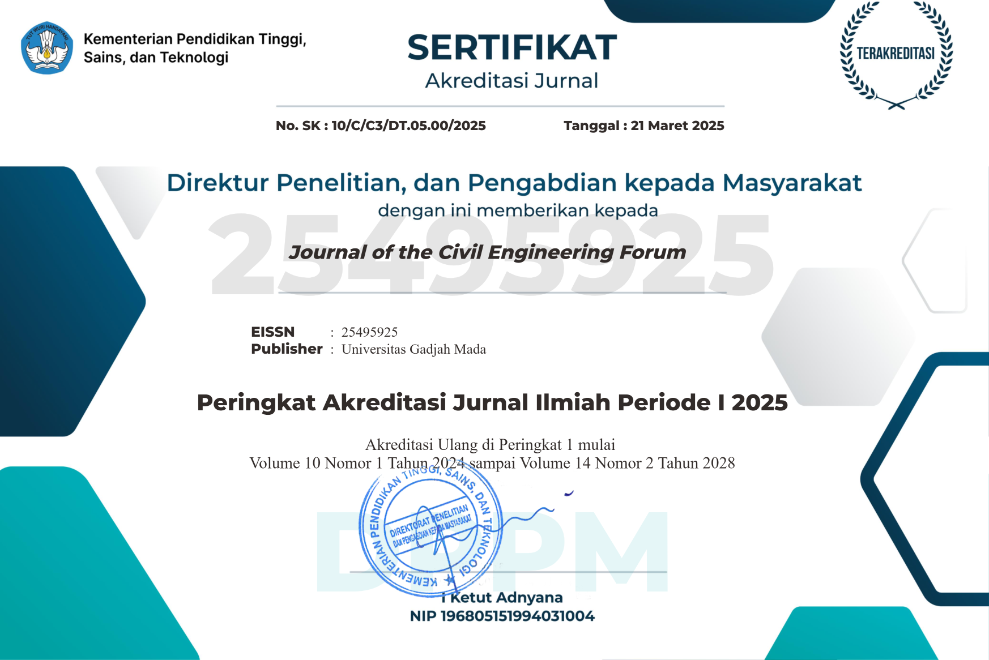The Determination of Downhole Dynamic Compaction Paramaters Based on Finite Element Analysis
Abstract
Downhole dynamic compaction (DDC) has been commonly used in China to stabilize collapsible soil through the application of construction and demolition waste material (CDW). DDC basically forms a column inside the soil stratum which is similar to a stone column except DDC materials are put in sequence and then compacted by using DDC hammer. Due to its attractive features such as its big diameter, feasibility of using oversized material particles, rapid and simple construction technique, it is used as one of the ground improvement methods for an airport project in Indonesia. Despite of all the advantages provided by DDC, it is difficult to obtain DDC parameters from laboratory tests as it is difficult to replicate the compaction effort induced by the DDC hammer and laboratory tests are not commonly employed for oversized materials. Hence, alternative method is required to evaluate DDC parameters. In this study, static load test is conducted to determine load-deformation curve of the DDC pile. Soil parameters are first determined through soil test data such as standard penetration test (SPT), laboratory test and also pressure meter tests. Correlation between pressure meter tests and SPT test result is also carried in order to interpret the soil parameter at the site. Axisymmetric finite element analysis is then carried by using MIDAS GTS NX in order to back analyses DDC parameters by matching the simulation curve with load settlement curve of the DDC. In this paper, it is shown that back analysis using hardening soil model for DDC material can be used to match simulation curve with the load-deformation curve.
References
Amar, S. and Jézéquel, J.F. 1972. Essais en place et en laboratoire sur sols cohérents: comparaison des résultats. Bulletin de Liaison des Ponts et Chaussées 58 97-108.
Ameratunga, J., Sivakugan, N. and Das, B.M. 2016. Correlations of Soil and Rock Properties in Geotechnical Engineering. India: Springer.
Bjerrum, L. and Simons, N.E. 1960. Comparison of Shear Strength Characteristics of Normally Consolidated Clay. Research Conference on Shear Strength of Cohesive Soils, ASCE.
Budhu, M. 2010. Soil Mechanics and Foundations. 3rd ed. ed. Hoboken NJ: Wiley.
Butler, F.G. 1975. Heavily overconsolidated clays. General report and state-of-the-art review for session. Proc. 3rd Conf. on Settlement of Structures, London, Pentech Press.
Feng, S.-J., Shi, Z.-M., Shen, Y. and Li, L.-C. 2015. Elimination of loess collapsibility with application to construction and demolition waste during dynamic compaction. Environmental Earth Sciences 73(9) 5317-5332.
Kenney, T.C. 1959. Discussion of geotechnical properties of Glacial Lake clays by Wu, T. H. J. Soil Mech. and Found. Div 85(SM3) 67-79.
Ladd, C.C. et al. 1977. Stress-deformation and strength characteristics. Proc. 11th Int. Conf. on Soil Mech. and Found. Eng. Tokyo. 421-494.
Mayne, P. and Kemper, J.B. 1988. Profiling OCR in Stiff Clays by CPT and SPT. Geotechnical Testing Journal - GEOTECH TESTING J 11.
Mayne, P.W. 2013. Evaluating Yield Stress of Soils From Laboratory Consolidation and in-Situ Cone Penetration Tests. Sound Geotechnical Research to Practice. pp. 405-419.
Mayne, P.W. 2014. Generalized CPT Method for Evaluating Yield Stress in Soils. Geo-Congress 2014 Technical Papers. pp. 1336-1346.
Pangaribuan, P.J. 2021. Korelasi antara yield stress dan kompresibilitas tanah residual kediri dengan nilai N dari uji standard penetration test. Engineering. Bandung, Indonesia, Universitas Katolik Parahyangan.
Peck, R.B., Hanson, W.E. and Thornburn, T.H. 1974. Foundation Engineering. 2nd Edition. New York: John Wiley and Sons.
Schanz, T., Vermeer, P.A. and Bonnier, P.G. 1999. The hardening soil model: Formulation and verification. pp. 281-296.
Schnaid, F. 2009. In Situ Testing in Geomechanics the main test: Taylor & Francis.
Sorensen, K.K. and Okkels, N. 2013. Correlation between Drained Shear Strength and Plasticity Index of Undisturbed Overconsolidated Clays. Proceedings of the 18th International Conference on Soil Mechanics and Geotechnical Engineering. Paris.
Wesley, L.D. 2010. Geotechnical Engineering in Residual Soils.
Zhang, W. and Wu, Q. 2012. Development Model for Construction Waste Management of China. ICSDC 2011. pp. 421-430.
Copyright (c) 2022 The Author(s)

This work is licensed under a Creative Commons Attribution-ShareAlike 4.0 International License.
Copyright is granted to authors for the purpose of providing protection for articles written to describe experiments and their results. JCEF will protect and defend the work and reputation of the author and are also willing to address any allegations of violation, plagiarism, fraud, etc. against articles written and published by JCEF. JCEF is published under the terms of the Creative Commons Attribution-ShareAlike 4.0 International License (CC BY-SA 4.0). The author holds the copyright and assigns the journal rights to the first publication (online and print) of the work simultaneously.







